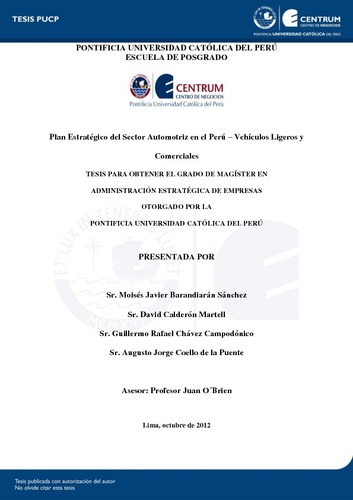| dc.contributor.advisor | O’Brien Cáceres, Juan | |
| dc.contributor.author | Barandiarán Sánchez, Moises Javier | es_ES |
| dc.contributor.author | Calderón Martell, David | es_ES |
| dc.contributor.author | Chávez Campodónico, Guillermo Rafael | es_ES |
| dc.contributor.author | Coello de la Puente, Augusto Jorge | es_ES |
| dc.date.accessioned | 2013-06-06T01:26:37Z | |
| dc.date.available | 2013-06-06T01:26:37Z | |
| dc.date.created | 2012 | |
| dc.date.issued | 2013-06-05 | |
| dc.identifier.uri | http://hdl.handle.net/20.500.12404/4614 | |
| dc.description.abstract | El planeamiento estratégico del sector automotriz tiene como objetivo principal buscar su desarrollo sostenible, aprovechando el crecimiento económico del país y el dinamismo del sector, a través del establecimiento de estrategias que permitan posicionarlo como uno de los sectores referentes en Latinoamérica, buscando el bienestar de sus stakeholders e impactando en menor medida en el medio ambiente.
Este documento toma como referencia modelos exitosos aplicados en países de la región. Dichos modelos fueron desarrollados en condiciones menos favorables con las que cuenta el sector automotriz, en la actualidad. Además, demuestra que se puede impulsar al sector para hacerlo más competitivo, a través del aprovechamiento de una ventaja comparativa.
Por otro lado, este estudio muestra que muchos de los objetivos planteados son susceptibles de alcanzar, debido a que existen factores que propician las condiciones para su concreción, tales como (a) tratados de libre comercio con países fabricantes, (b) aumento de la demanda de vehículos en el Perú y (c) altos índices de motorización en el Perú. Sin embargo, es importante mencionar que como parte del paquete de estrategias planteadas por este estudio, existen algunas cuyo funcionamiento depende necesariamente de la participación del Estado, el cual deberá crear las condiciones necesarias para propiciar la inversión en dicho sector. Estas condiciones pueden verse reflejadas a través de incentivos tributarios aplicados por un determinado periodo o por la promulgación de normas que restrinjan la importación de vehículos usados y fomenten la compra de los nuevos, ya que por el nivel de inversión que implica, este sector (a) cuenta con un gran potencial para la creación de puestos de trabajo formal, (b) incrementa la recaudación tributaria, (c) aumenta el PBI y (d) genera mayor dinamismo en la economía del país | es_ES |
| dc.description.abstract | The main purpose of the strategic plan in the automotive sector seeks sustainable development, taking advantage of the country's economic growth and dynamism of the sector, through the establishment of strategies to position it as one of the main sectors in Latin America, worrying about welfare of its stakeholders and impacting in less measure in the environment.
This paper draws on successful models applied in countries of the region; these models were developed in less favorable conditions as the one we have in Peru’s automotive sector today. Additionally, it shows how exploiting a comparative advantage, the sector can be improved to make it more competitive.
Furthermore, this study shows that many of the objectives are likely to be achieved, because there are factors favoring the conditions for its realization. These factors are as follows: (a) free trade agreements with producing countries, (b) increased demand for vehicles in Peru, and (c) high rates of motorization in Peru. However, it is important to mention that as part of the package of strategies proposed by this study, there are some whose operation necessarily depends on the participation of the state, which will create the conditions to encourage investment in this sector, these conditions can be reflected through tax incentives applied for a certain period or for the promulgation of regulations restricting the import of used vehicles and encourage the purchase of new ones. This is because the sector, due to the level of investment involved, has great potential for the creation of formal jobs, increase tax revenues, increase GDP and generate greater dynamism in the economy. | es_ES |
| dc.language.iso | spa | es_ES |
| dc.publisher | Pontificia Universidad Católica del Perú | es_ES |
| dc.rights | info:eu-repo/semantics/openAccess | es_ES |
| dc.rights.uri | http://creativecommons.org/licenses/by-nc-nd/2.5/pe/ | * |
| dc.subject | Industria automotriz--Perú | es_ES |
| dc.title | Plan estratégico del sector automotriz en el Perú : vehículos ligeros y comerciales | es_ES |
| dc.type | info:eu-repo/semantics/masterThesis | es_ES |
| thesis.degree.name | Magíster en Administración Estratégica de Empresas | es_ES |
| thesis.degree.level | Maestría | es_ES |
| thesis.degree.grantor | Pontificia Universidad Católica del Perú. CENTRUM | es_ES |
| thesis.degree.discipline | Administración Estratégica de Empresas | es_ES |
| renati.advisor.dni | 07873020 | |
| renati.advisor.orcid | https://orcid.org/0000-0002-1019-2224 | es_ES |
| renati.discipline | 413307 | es_ES |
| renati.level | https://purl.org/pe-repo/renati/level#maestro | es_ES |
| renati.type | https://purl.org/pe-repo/renati/type#tesis | es_ES |
| dc.publisher.country | PE | es_ES |
| dc.subject.ocde | https://purl.org/pe-repo/ocde/ford#5.02.04 | es_ES |






